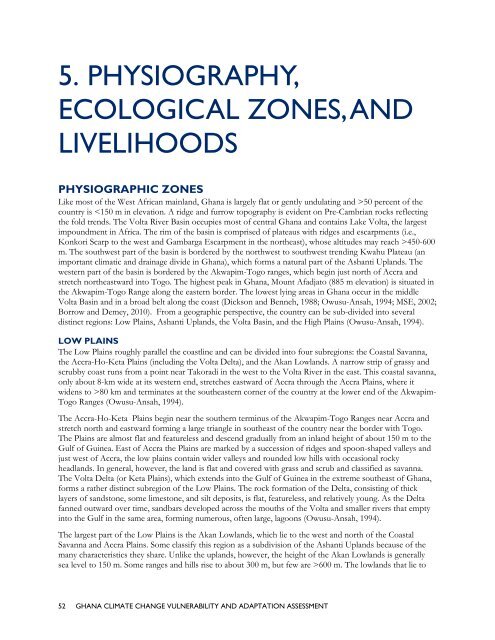ghana climate change vulnerability and adaptation assessment
ghana climate change vulnerability and adaptation assessment
ghana climate change vulnerability and adaptation assessment
- No tags were found...
You also want an ePaper? Increase the reach of your titles
YUMPU automatically turns print PDFs into web optimized ePapers that Google loves.
5. PHYSIOGRAPHY,ECOLOGICAL ZONES, ANDLIVELIHOODSPHYSIOGRAPHIC ZONESLike most of the West African mainl<strong>and</strong>, Ghana is largely flat or gently undulating <strong>and</strong> >50 percent of thecountry is 450-600m. The southwest part of the basin is bordered by the northwest to southwest trending Kwahu Plateau (animportant climatic <strong>and</strong> drainage divide in Ghana), which forms a natural part of the Ashanti Upl<strong>and</strong>s. Thewestern part of the basin is bordered by the Akwapim-Togo ranges, which begin just north of Accra <strong>and</strong>stretch northeastward into Togo. The highest peak in Ghana, Mount Afadjato (885 m elevation) is situated inthe Akwapim-Togo Range along the eastern border. The lowest lying areas in Ghana occur in the middleVolta Basin <strong>and</strong> in a broad belt along the coast (Dickson <strong>and</strong> Benneh, 1988; Owusu-Ansah, 1994; MSE, 2002;Borrow <strong>and</strong> Demey, 2010). From a geographic perspective, the country can be sub-divided into severaldistinct regions: Low Plains, Ashanti Upl<strong>and</strong>s, the Volta Basin, <strong>and</strong> the High Plains (Owusu-Ansah, 1994).LOW PLAINSThe Low Plains roughly parallel the coastline <strong>and</strong> can be divided into four subregions: the Coastal Savanna,the Accra-Ho-Keta Plains (including the Volta Delta), <strong>and</strong> the Akan Lowl<strong>and</strong>s. A narrow strip of grassy <strong>and</strong>scrubby coast runs from a point near Takoradi in the west to the Volta River in the east. This coastal savanna,only about 8-km wide at its western end, stretches eastward of Accra through the Accra Plains, where itwidens to >80 km <strong>and</strong> terminates at the southeastern corner of the country at the lower end of the Akwapim-Togo Ranges (Owusu-Ansah, 1994).The Accra-Ho-Keta Plains begin near the southern terminus of the Akwapim-Togo Ranges near Accra <strong>and</strong>stretch north <strong>and</strong> eastward forming a large triangle in southeast of the country near the border with Togo.The Plains are almost flat <strong>and</strong> featureless <strong>and</strong> descend gradually from an inl<strong>and</strong> height of about 150 m to theGulf of Guinea. East of Accra the Plains are marked by a succession of ridges <strong>and</strong> spoon-shaped valleys <strong>and</strong>just west of Accra, the low plains contain wider valleys <strong>and</strong> rounded low hills with occasional rockyheadl<strong>and</strong>s. In general, however, the l<strong>and</strong> is flat <strong>and</strong> covered with grass <strong>and</strong> scrub <strong>and</strong> classified as savanna.The Volta Delta (or Keta Plains), which extends into the Gulf of Guinea in the extreme southeast of Ghana,forms a rather distinct subregion of the Low Plains. The rock formation of the Delta, consisting of thicklayers of s<strong>and</strong>stone, some limestone, <strong>and</strong> silt deposits, is flat, featureless, <strong>and</strong> relatively young. As the Deltafanned outward over time, s<strong>and</strong>bars developed across the mouths of the Volta <strong>and</strong> smaller rivers that emptyinto the Gulf in the same area, forming numerous, often large, lagoons (Owusu-Ansah, 1994).The largest part of the Low Plains is the Akan Lowl<strong>and</strong>s, which lie to the west <strong>and</strong> north of the CoastalSavanna <strong>and</strong> Accra Plains. Some classify this region as a subdivision of the Ashanti Upl<strong>and</strong>s because of themany characteristics they share. Unlike the upl<strong>and</strong>s, however, the height of the Akan Lowl<strong>and</strong>s is generallysea level to 150 m. Some ranges <strong>and</strong> hills rise to about 300 m, but few are >600 m. The lowl<strong>and</strong>s that lie to52 GHANA CLIMATE CHANGE VULNERABILITY AND ADAPTATION ASSESSMENT
















